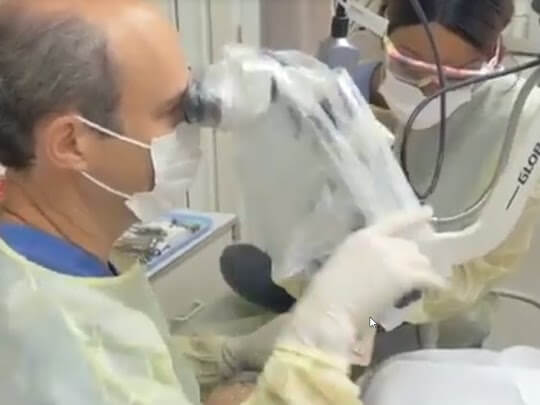Crown lengthening is a surgical technique to remove gum tissue, bone, or both to expose more of a tooth. Often a patient requires a specific tooth to be fixed, perhaps because a tooth doesn’t stick out enough or because it is broken. In addition, crown lengthening can treat a smile with too much gum tissue around the upper teeth. Crown lengthening as a surgical procedure is very common. New York City patients should visit their local dentist before looking into crown lengthening. Your dentist will review your medical history and decide if the procedure is necessary. Dr. Kissel is a leader in crown lengthening services and is at the forefront of technology that may revolutionize the procedure using microsurgery. When you receive care from Dr. Kissel, you can trust that your procedure will be a smooth, easy, and quality job.
The Difference between Traditional and Microsurgical Techniques
Traditional crown lengthening services, however, cannot provide the best care. Using traditional techniques, you will often need to revisit the periodontist within 10 days and may require up to 6 weeks for healing and follow-ups. In addition, gum healing can take up to three months before the final crown can be placed. Dr. Kissel uses newer techniques that utilize micro-surgical technology to enhance the operation. These techniques greatly improve healing time, but also reduce the risks of infection, sensitivity, pain, and the possibility of tooth loss. Below is a patient that benefitted immensely from micro-surgical crown lengthening.
This patient has a very high smile and is frequently under public scrutiny. This type of patient requires particularly careful surgical treatment planning and predictable results. Traditional periodontal crown lengthening procedures would not ensure the patient’s ability to heal quickly and could, therefore, result in a compromised lifestyle. In addition, with traditional care patients often experience pain, gingival deficiency, soft tissue scars, or non-confluent tissue closure. Using microsurgical techniques can achieve better results. They maximize the healing response as well as eliminating post-operative discomfort because blood vessels reconnect within 48 hours. Dr. Kissel has been using an alternative incision design for crown lengthening that cannot be employed with traditional periodontal techniques. The incisions are made with a microsurgical blade and are located horizontally near the base of the papilla. This design predictably maintains the entire papilla and results in absolute primary closure.
Microsurgical Crown Lengthening Procedure
Day of Surgery
The use of a micro-surgical blade makes incisions barely visible. 7-0 monofilament sutures close horizontal incisions, which are minimally traumatic. The osseous reduction was performed, and primary closure was achieved. Already we see the improvements that micro-surgical technology can bring to a simple procedure.
1 Week Later
The healing seen here is similar to a traditional case at 3-4 weeks post-op. The patient had no discomfort and was back at her photo shoot in 3-4 days. Micro-surgical techniques have cut the healing time to nearly a quarter as expected of traditional crown lengthening.
Dr. Kissel is a leading New York City expert in micro-surgical techniques. Bringing those skills to augment traditional crown lengthening services can achieve these types of results consistently and with a high degree of quality.
New York City demands that everyone look their best. Crown lengthening services at Dr. Kissel’s New York City office can help you look your best. Dr. Kissell provides the best in crown lengthening services and can do the same for you.
The next time you are looking for a better smile in New York City, call Dr. Kissel’s office in New York City for a consultation at (212) 702-9088 or book online.
